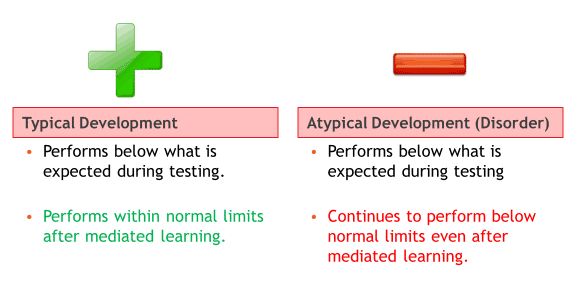 We all have finished a formal evaluation, found that a child qualifies, and you…
We all have finished a formal evaluation, found that a child qualifies, and you…
- don’t really believe the results and wonder if culture, exposure, attention span or something else is making the results wonky.
- know the child qualifies but don’t have a clue how to write goals to get him to move forward.
Here are 4 steps to show how dynamic assessment can help us figure this out and a free downloadable Dynamic Assessment Protocol that we put together to make this easy.
But first… What is Dynamic Assessment?
Dynamic assessment is a lot of things:
- It is a less-biased approach for determining when there is a language difference rather than a language disorder because of second-language influence.
- It is an interactive and process-oriented procedure to measure language learning potential. It is a test-teach-retest model based on Vygotsky’s Zone of Proximal Development (ZPD).
- It provides us with concrete intervention targets via “mediated learning” (Feuerstein).
There is a lot to be praised about dynamic assessment but how do we reap the rewards within the testing timeframes that we have been given?
Dynamic assessment enables us to take areas of concern that have shown up on formal testing and systematically put them through a quick 5-step process.
Step 1: Choose an area on formal testing where the child did not do well.
Step 2: Attempt to teach the skill. The quickest way to teach new skills and get reliable results is to use Mediated Learning. This is what it would look like:
Strategy |
Purpose |
Example |
Intentionality: | What’s the goal?
State the purpose of the teaching. | We’re going to work on following directions that have 3 steps. |
Meaning: | Why are we working on this?
Tell why it’s important and relevant. | When someone gives you directions, it’s important to do each step so that you finish the task. |
Transcendence: | What happens if we don’t have this skill?
Develop awareness of the relevance of the skill to real life through critical thinking. | What if your teacher tells you to color, cut, and glue, but you only follow two of the directions? Then your project wouldn’t be finished. |
Application: | Here’s what I expect you to do. Let’s try it together.
Clarify expectations and give explicit instructions. Provide a model and allow opportunities for practice. | This time when I give you a direction that has 3 steps, I want you to do all 3 steps in the order that I say them. I’ll do it first and then it will be your turn. |
Competence: | What did you learn? Why is it important? When will you use this skill?
Check for understanding of the skill and its importance for the current context and future classroom activities. | Remember, it’s important to listen to all the steps in a direction and follow each one.
Now you tell me what we practiced and why it’s important. Think about when you might need to follow directions correctly in the classroom. Then we’ll try it five more times. |
Step 3: Record how much you had to support the student:
Minimal |
Moderate |
Maximum |
| Repetition
Rephrasing Slowed rate 1-2 presentations | Modeling correct response
Providing a demonstration Multi-sensory input Multiple (3-4) prompts | Direct imitation (verbal)
Physically prompted (non-verbal) Reduced Content Performs task for child |
Step 4: Determine whether the area needs to be addressed in therapy or be included as a reason for qualification.

So Why do Dynamic Assessment?
Dynamic Assessment provides an alternative approach that focuses on learning. It:
helps us determine difference vs. disorder
helps us identify how much support a child needs to be successful
helps us determine appropriate goals
For more information on how to make this happen, watch this online video course and download the Dynamic Assessment Protocol.


 We all have finished a formal evaluation, found that a child qualifies, and you…
We all have finished a formal evaluation, found that a child qualifies, and you…

I find this type of assessment very useful specially with bilingual students.
This is awesome and so needed. Thank you!
I use this page when teaching my graduate class on Language Assessment. Thank you!
Hi Cathy,
So glad to hear that. I love to know that our rising SLPs are being equipped with this information that they’ll need when they hit the field!
Best, Ellen